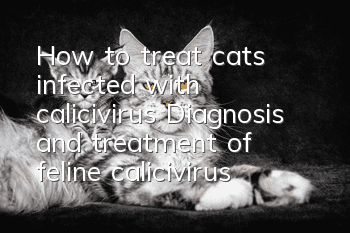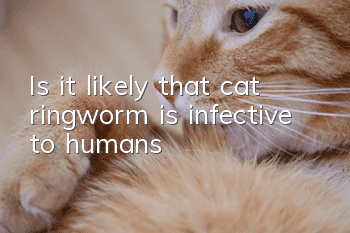How to treat cats infected with calicivirus? Diagnosis and treatment of feline calicivirus!

How to treat cats infected with calicivirus? Diagnosis and treatment of feline calicivirus! Feline calicivirus infection (FCV), also known as infectious rhinotracheitis, is a feline disease caused by feline calicivirus. Multiple oral and respiratory infectious diseases. The main symptoms are upper respiratory tract symptoms, biphasic fever, serous and mucus rhinorrhea, conjunctivitis, depression, and some cats may hear respiratory rales, difficulty eating, salivation, oral ulcers, etc. Recently, our hospital has cured many cases of this disease, and we would like to share our diagnosis and treatment experience with you.
1. Course of onset and clinical symptoms:
On August 27, the pet owner brought the cat to our hospital for treatment. The cat mainly showed difficulty in eating. , salivation, clinical examination found ulcers of varying sizes on the tongue surface. A few days later, the other three cats in the owner's home developed the same symptoms. The main clinical symptoms were decreased appetite, salivation, and sticky transparent secretions hanging on the lips; there were various ulcers on the tongue, mostly concentrated on the tongue. On the back of the tongue, the ulcer was slightly sunken, red, and had uneven edges; the cat kept licking the mouth with its tongue due to tongue discomfort; three had a slight increase in body temperature, with the highest reaching 39.7 degrees Celsius, and one had no increase in temperature; two Only dryness and cracks on the nose appear; severe mental depression, but no obvious changes in other mental states.
Figure 2 Typical symptoms of calicivirus
2. Laboratory diagnosis;
2.1 Virus isolation test: collect samples from infected cats Oral secretions were sent for examination, and the virus was isolated. The saliva was properly processed and inoculated with F81 cells, which were passed blindly to the fourth generation. Cell lesions appeared, with cells shrinking, fusion, and finally completely falling off and suspending.
2.2 Electron microscopy detection: Take the supernatant of the infected cell culture and observe it under negative electron microscopy, and you can see calicivirus particles. Using ultrathin sections of electron microscope to observe the cellular components, calicivirus particles arranged in a crystal lattice can be seen in the cytoplasm.
2.3 Toxicity determination: Take the limbs of 40-day-old test cats, then divide them into two groups and raise them in isolation. In the first group, each cat was inoculated intranasally and orally with 2 ml of saliva secreted by the sick cat; in the second group, the control group was inoculated with an equal amount of normal saline according to the method of the first group. After receiving the poison, the clinical symptoms were observed every day, and on the third The oral secretions of the infected cats were collected and sent for examination within five days. As a result, the body temperature of the exposed group increased, and symptoms such as ulcers on the nose and tongue edges, decreased appetite, and salivation appeared on the sixth day after exposure. On the fifth day after exposure, the drug could be isolated from the oral secretions of the two test cats. FCV; while in the control group, there were no abnormalities in clinical observation and virus isolation was negative.
3. Treatment measures:
① Immediately isolate the sick cat in the hospital for hospitalization, and use disinfectants to disinfect the floor, cages, utensils, etc. every day .
② Antiviral: use ribavirin, thymosin, etc.
③Clean the mouth every day: Open the sick cat’s mouth and useRinse the mouth with 0.1% potassium permanganate, and apply cod liver oil or spray Guilin watermelon cream on the ulcer surface.
④Prevent secondary infection: Use ceftriaxone sodium infusion for treatment.
⑤ Vitamin supplement: Use vitamin B complex, vitamin B2, vitamin B6, vitamin C, etc.
⑥For those with more serious illness and poor mental appetite, supportive therapy is adopted, including intravenous infusion of 5% glucose saline, 10% glucose, ATP, coenzyme A, etc.
After taking the above comprehensive treatment measures, cats with mild illness will recover in 5 to 7 days; cats with more severe illness will recover in about 10 to 15 days.
4. Disease prevention
4.1 Cushions, beddings, and cages used by cats at home should be changed frequently, disinfected, and taken out when the weather is fine. Bask in the sun;
4.2 Regularly vaccinate cats against triple leukopenia, feline viral bronchitis, and feline calicivirus disease every year to reduce the risk of cat disease;
4.3 If If a cat is found to be sick at home, it should be kept separately from other pets immediately and sent to a pet hospital for medical treatment in a timely manner;
4.4 Under natural conditions, only felines are susceptible to feline calicivirus, and it often occurs Cats aged 6-84 days. The main sources of infection of this disease are sick cats and virus-carrying cats. The former can discharge a large amount of virus with secretions and excretions in the acute phase, contaminating utensils, floors and objects, and can also be directly transmitted to cats. The latter usually results from cases in the acute phase. Although the clinical symptoms disappear, it can detoxify for a long time and is the most important and dangerous source of infection. Therefore, reducing the contact between pet cats at home and infected cats in the wild is the key to cutting off the source of infection.
5. Summary and discussion:
5.1 Based on clinical symptoms and laboratory tests, the history was confirmed to be caused by calicivirus (FCV) infection. Under natural conditions, only felines are susceptible to FCV, with a high incidence of the disease and a high mortality rate in young cats. Adult cats often have mild passing or latent infection if there is no secondary infection. This time, all five cats recovered after treatment and care, and none of them died. This is also related to the fact that these cats are all adult cats. Since there is currently no vaccine to prevent this disease in China, prevention mainly depends on paying attention to feeding hygiene and reducing the contact between cats and sick cats from outside.
5.2 The clinical manifestations of this disease are diverse. It can manifest as fever, sneezing, discharge of mucus or purulent nasal fluid and tears, increased secretions from the mouth, nose, and eyes, oral ulcers, and conjunctivitis. When the virus is highly virulent, pneumonia can occur with symptoms such as difficulty breathing. Oral ulcers are a common and characteristic symptom, and sometimes the only symptom. This time, five cats became ill in a group, and their clinical symptoms fell into this type.
5.3 Regarding the cause of this disease, it may be that wild cats in the wild bring the virus indoors after contact with domestic cats, and then transmit it to other cats in the same category.Raised cats.
- What is feline chlamydia? Symptoms and prevention methods of feline chlamydia
- How to train Persian cats differently in different scenarios?
- How to get a cat to sit quietly in the car
- Is it better for cats to eat dry food or wet food?
- Will the female cat urinate?
- Why does a black cat grow white hair?
- Is it normal for a cat to sneeze three or four times a day?
- Gold Gradient Male and Silver Gradient Female Match
- The cat is lame and can't touch the ground with one foot
- Cat's broken teeth are red in the middle



